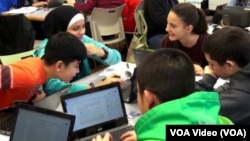In New York City public schools, 176 different languages are spoken among the more than 1 million students.
For 160,000 children, English is not their first language. New York’s Department of Education makes learning better for these students by providing dual-language programs.
Students are taught in two languages, English and another one, like Russian or Chinese. Math, social studies, science and all other regular courses are taught in both languages. And they learn about the culture of the other country.
Milady Baez is Deputy Chancellor of English Language Learners and Student Support. She says these dual-language programs will help children succeed in the future.
"The jobs of the future require that our students know more than one language. They are going to be traveling abroad, they are going to be communicating with people from all over the world. This will open doors for them.”
David A. Booty Middle School in Brooklyn offers dual language education in four languages: Russian, Mandarin, Spanish and Hebrew.
Shuya Zhang teaches a dual language class. She says the program helps children get ready to work with people in other countries.
"Look at now-a-days, America started economic relationships with China. Lots of factories have been built, companies moved to China. They need people with the skills with both language skills so the kids when they are grown up, they already have this skill.”
Middle-schoolers might not have jobs on their minds yet. For Kequing Jaing, she likes keeping up her first language, Mandarin.
“It makes me, like, feel that I am home because I can speak in Chinese, learn in Chinese, while learning in English. So it makes me feel better and makes me understand more about the task I’m learning.”
Anastasia Hudikova came to the United States when she was 2 years old. She says the Russian-English program keeps her connected to her heritage and her parents happy.
“They’re really happy about the program that it exists. They are really happy that I can preserve my culture and my language, that I can speak it fluently in school.”
The New York schools also offer dual-language programs in seven other languages: Arabic, French, Haitian Creole, Hebrew, Korean, Polish and Spanish. There are plans to add even more languages in the future.
While these dual-language programs are popular, some groups in the U.S. say teaching English comes first. U.S. English wants to make English the official language of the United States.
“We have no problem with folks speaking multiple languages … if people want to speak a different language at home,” says Todd DuBois with U.S. English. “What we do think is schools should prioritize English.”
He says studies show that children who learn English early will be more successful later. And, he says, focusing on English in the classroom will help the students learn the language faster.
I’m Anne Ball.
Michael Lamon reported this story. Anne Ball produced it and Kathleen Struck was the editor.
We want to hear from you. Write to us in the Comments section and on our Facebook page.
________________________________________________________________
Words in This Story
dual-language – n. being taught in two different languages
courses – n. school class or program
heritage – n. the traditions, achievements, beliefs, etc., that are part of the history of a nation or a group of people
folks – n. people
multiple – adj. many
prioritize – v. to make something the most important in a group








